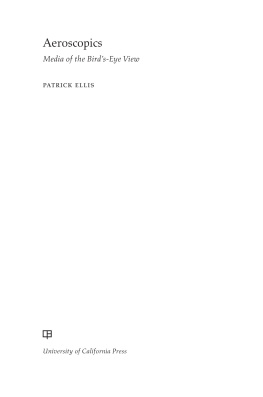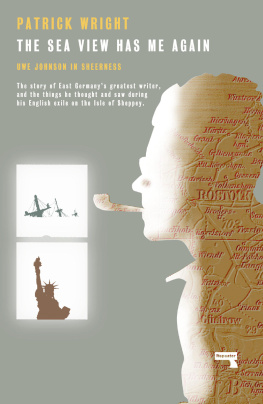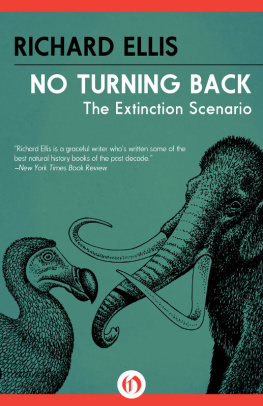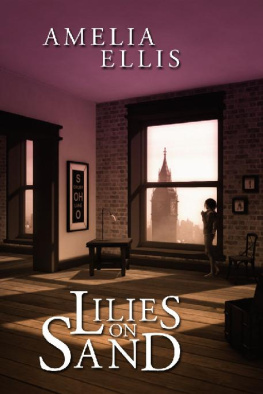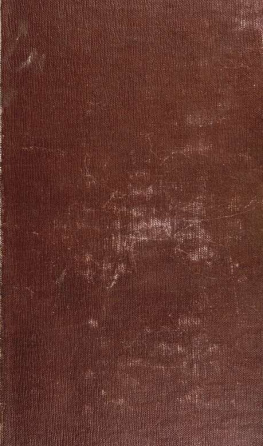Aeroscopics
The publisher and the University of California Press Foundation gratefully acknowledge the generous support of the Richard and Harriett Gold Endowment Fund in Arts and Humanities.
Aeroscopics
Media of the Birds-Eye View
PATRICK ELLIS

University of California Press
University of California Press
Oakland, California
2021 by Patrick Ellis
Library of Congress Cataloging-in-Publication Data
Names: Ellis, Patrick, 1980- author.
Title: Aeroscopics : media of the birds-eye view / Patrick Ellis.
Description: Oakland, California : University of California Press, [2021] | Includes bibliographical references and index.
Identifiers: LCCN 2020051190 (print) | LCCN 2020051191 (ebook) | ISBN 9780520355484 (cloth) | ISBN 9780520355491 (paperback) | ISBN 9780520975934 (epub)
Subjects: LCSH : Paris (France)Aerial viewsHistory20th century.
Classification: LCC DC 707 . E 39 2021 (print) | LCC DC 707 (ebook) | DDC 914.4/36100222dc23
LC record available at https://lccn.loc.gov/2020051190
LC ebook record available at https://lccn.loc.gov/2020051191
Manufactured in the United States of America
30 29 28 27 26 25 24 23 22 21
10 9 8 7 6 5 4 3 2 1
Contents
Acknowledgments
While writing this book, I obtained one habit of the nineteenth-century tourist: upon arrival in a new city, I aimed for the highest view one could access. Looking down from these perches now, in retrospect, I see below a map of gratitude.
From the campanile at the University of California, Berkeley, overlooking the campus where this project had its genesis: my great thanks to Mark Sandberg, who fundamentally changed the way that I look at spectacles past and present; to Kristen Whissel, for always having the mot juste; and to David Bates, guide to media and scientific arcana. Also to Barry Pateman, the anarchist authority on Bay Area archives; Gray Brechin, a marvelous coconspirator and host; Kathy Geritz, who shepherded ideas from this book into a film series at the Pacific Film Archive; Laura Horak, who offered sage advice from day one; and Linda Williams, who provided living proof that the study of film should be ebullient.
Berkeley is also where this manuscript, folded into a paper airplane, found its publishing house. There, I have received careful, animating editorial guidance from Raina Polivka and Madison Wetzell, along with crystalizing commentary from my reviewers. Elsewhere in the hills and streets of the East Bay, I had the good fortune to trade ideas with Nicholas Baer, Eliot Bessette, Jennifer Blaylock, Norman Gendelman, Jennifer Malkowski, Rene Pastel, and Justin Vaccaro.
In Atlanta, from the Westin Peachtree Plaza, I spy the Georgia Institute of Technology, where I finished this book. There was a supportive crew on the ground: thanks to Ben Bergholtz, Annika Orich, Nick Sturm, Anu Thapa, and Gregory Zinman. Rebecca Burnett and Andy Frazee showed me how to better tie my research to my teaching. I found ideal collaborators in Jerushia Graham, Wendy Hagenmaier, Virginia Howell, and Anna Westersthl Stenport.
Atop the Glasgow Lighthouse, I owe a special thanks to my old friend and collaborator Jesse Olszynko-Gryn, who accompanied me over years of memorable drives to some of the more important pinnacles of the continent. Other far-flung fellow travelers I must thank for their hospitality and insight: Tom Conley, Joe Culpepper, Oliver Gaycken, Nick Hopwood, and Isabelle McNeill. The late Ralph Hyde demonstrated an inspiring intellectual generosity.
The list of archives, museums, funding bodies, and speakers series that helped with this project could not be counted on any ordinary map. To single out a few: my thanks are owed to James Akerman at the Newberry Library, Patrick Deicher at the Bourbaki Panorama, Melissa Keiser at the Smithsonian National Air and Space Museum, Peter Kelly of the Douglas Victorian Society, and Jon Mogul at the Wolfsonian Museum. It has been a boon to have the support of various funding bodies, especially the American Council of Learned Societies, the J.B. Harley Research Trust, the National Endowment for the Humanities, and the Social Sciences and Humanities Research Council of Canada, without whose assistance I could not have performed my research. I was gratified to discuss ideas from this book with the David Rumsey Map Center at Stanford University, the George Washington Wilson Centre for Visual Culture at the University of Aberdeen, and the Centre for Film and Screen and the Twentieth Century Think Tank at the University of Cambridge.
Three final views, closer to home.
Looking down from a minaret in Plant Hall, Im grateful to my new colleagues at the University of Tampa for such a generous welcome. Future collaborations are in store.
In Halifax, from Citadel Hill: thank you to the Ellises, to Ann and John Paul, for everything. The border is closed as I write, but we will fly over it again.
And from a hot air balloon, here or there, but always with Vanessa. More balloon rides to come. Next time well bring the kids.
Patrick Ellis
August 2020
Introduction
Spotting the Spot
Flying over Colorado, looking out of the window, I compare the topography below with the seatback screen map, trying to better understand what I am seeing. Such screens are dwindling, becoming an obsolete form of aerial vision. I remember the first time that I performed this cartographic crosscheck. Thinking back over other aerial firsts that transpired during the years that went into this book, four scenes come to mind.
Chicago, 2009: A father and son take the elevator more than one thousand feet up to the top of the Hancock tower. There, the boy looks out of the window at the city below. He suggests to his father that the city they are looking at is a fake, a scaled miniature.
Oakland, 2013: A consumer drone flies over the city. At first, it is assumed to be an airplane, but its unusual size and unfamiliar rotor buzz prompts many to look up and gaze at the new machine. Some stop in their tracks.
Lille, 2014: A historic scale model of the city is on display. Locals examine the exhibit, and struggle to reconcile it with the digital maps on their phones. Even the cardinal directions are difficult to orient.
Stanford, 2016: A student tries a virtual reality headset for the first time in the library. The immersive scene aims to replicate the experience of peering off of the open roof of a skyscraper. She becomes dizzy, and stumbles.
The aerial view, and the media that offer this vision, is in the zeitgeist. People are having their first experiences with virtual reality simulations of flight; with drones-eye views, both recreational and martial; and with the scalar play of Google Earth. This all seems new. But this impression of novelty is misplaced.
The aerial view was widely democratized in the nineteenth century, prior to commercial flight, prior even to widespread photographic circulation. There were devicescartographic devicesthat aimed to simulate this elevated view for a mass audience. Panorama paintings that reproduced a view from a great height; immense, miniature models of cities that circulated as proxies for a balloon view; filmic simulations of flight; observation rides that provided slow-moving aerial views of cities; and many others besides.
These media had many of the trappings and appeals of urban cartography (scaled, systemized, and symbolic representation), but none of a maps most common offering: wayfinding. Instead, within these topsy-turvy aerial viewing apparatuses, new cartographic attributes emerged: scale shifted erratically, time seemed to slow, and the maps legend was rewritten. Over the long nineteenth century, these media toyed with the norms of cartography. A fundamental change in the connotations and appeals of the aerial view occurred, as a contemplative form of scrutiny (patient analyses of static urban scenes) gave way to a ludic glance (disorienting glimpses of moving urban scenes). From observation to intoxication: this was mechanical objectivity made giddy by height.
Next page
